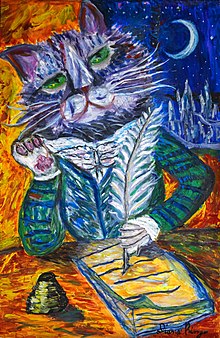

The Life and Opinions of the Tomcat Murr together with a fragmentary Biography of Kapellmeister Johannes Kreisler on Random Sheets of Waste Paper is a complex satirical novel by Prussian Romantic-era author E. T. A. Hoffmann. It was first published in 1819–1821 as Lebens-Ansichten des Katers Murr nebst fragmentarischer Biographie des Kapellmeisters Johannes Kreisler in zufälligen Makulaturblättern, in two volumes. A planned third volume was never completed.
Synopsis
| This section needs expansion. You can help by adding to it. (September 2022) |
The text of the book states it is the autobiography of a cat named Murr who has learned to write. The content of the book is therefore the life and work of the cat Murr, as written by Murr. However, in between Murr's autobiography, there are pages of a biography of another character, Johannes Kreisler.
Reception
Critic Alex Ross writes of the novel: "If the phantasmagoric 'Kater Murr' were published tomorrow as the work of a young Brooklyn hipster, it might be hailed as a tour de force of postmodern fiction."
Jeffrey Ford described the novel as a "complex, truly wild fiction" where Hoffmann "pieced together the fragments of his own shattered psyche and commented on the relationship of art and artists to society."
English translations
An English translation by Anthea Bell was published in 1999 by Penguin Classics.
Notes
- The title of the translation is reminiscent of The Life and Opinions of Tristram Shandy, Gentleman (1759–1767), the experimental novel by British writer Laurence Sterne.
References
- Hoffmeister, Gerhart (2006-10-15). "Kater Murr". The Literary Encyclopedia. Retrieved 2009-09-08.
- Ross, Alex (2009-08-24). "Imaginary Concerts: The Music of Fictional Composers". The New Yorker. p. 72.
- "Curiosities", F&SF, April 1999
External links
 Media related to Kater Murr at Wikimedia Commons
Media related to Kater Murr at Wikimedia Commons- Lebensansichten des Katers Murr by E. T. A. Hoffmann at Project Gutenberg (in German)
| E. T. A. Hoffmann | |
|---|---|
| Bibliography | |
| Novels |
|
| Short stories |
|
| Operas | |
| Miscellaneous |
|
This article about an 1810s novel is a stub. You can help Misplaced Pages by expanding it. See guidelines for writing about novels. Further suggestions might be found on the article's talk page. |